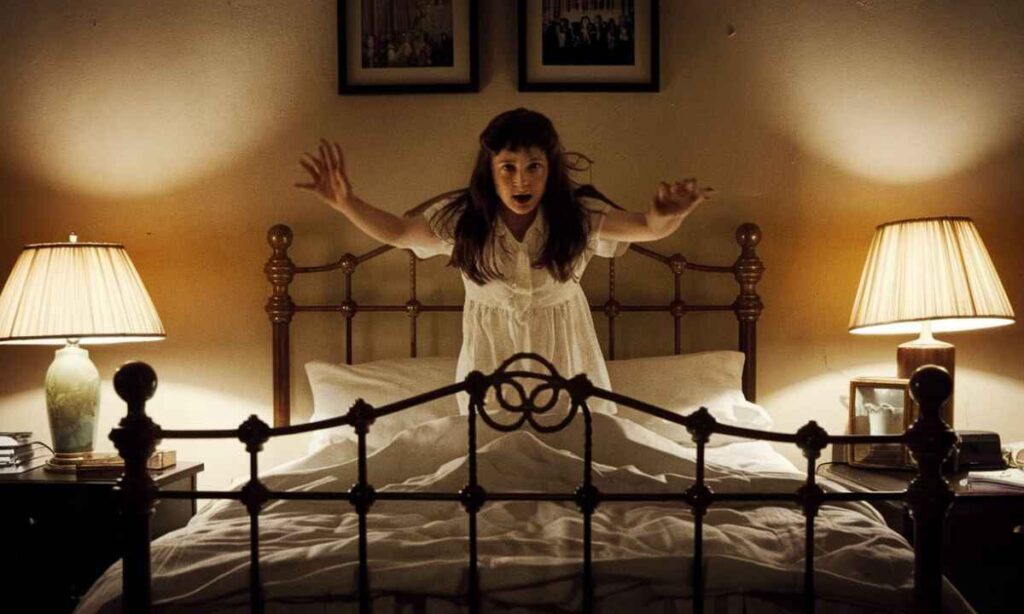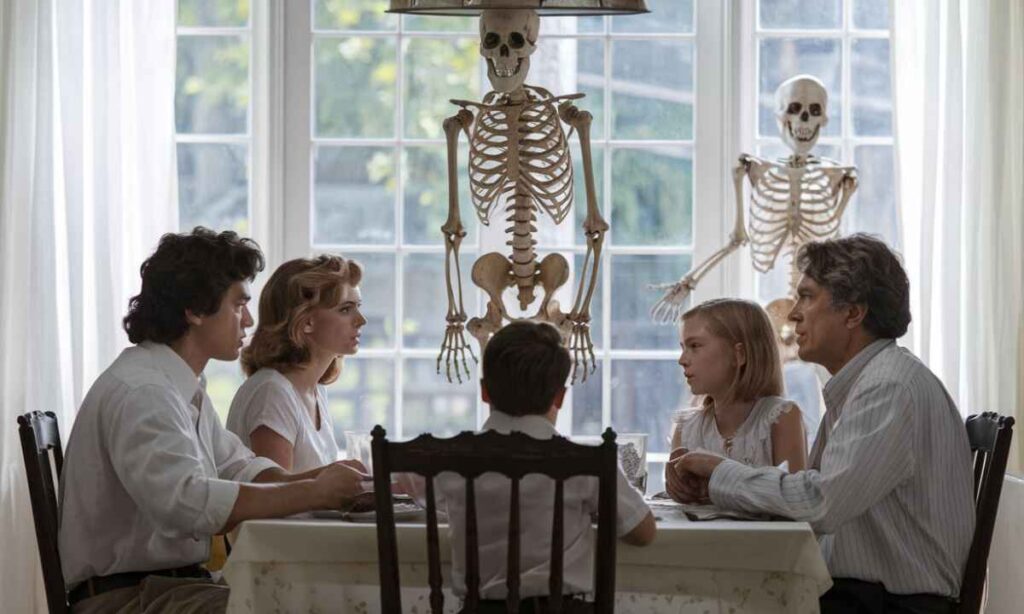In the realm of horror films, few have left as lasting an impact as the 1982 classic “Poltergeist“.
Directed by Tobe Hooper and produced by Steven Spielberg, this movie not only terrified audiences but also sparked a decades-long controversy surrounding its production methods.
At the heart of this debate lies a chilling claim: the use of real skeletons as props on set.
This article delves deep into the story behind “The 1982 Movie Poltergeist” and its alleged use of human remains, exploring the truth, implications, and lasting impact on the film industry.
Did they use real skeletons in Poltergeist?
The question that has haunted movie enthusiasts for years: did “Poltergeist” really use real skeletons in its production? The answer, as unsettling as it may be, appears to be yes. Multiple sources, including statements from cast members, have corroborated this claim over the years.
JoBeth Williams, who played Diane Freeling in the film, reportedly shared her discomfort about working with real human remains on set. In an interview, she mentioned:
“I had to swim in a pool with real skeletons. I didn’t know they were real until we were shooting the scene.”
This revelation sent shockwaves through the Hollywood community and sparked intense discussions about ethical behavior in filmmaking.
Is Poltergeist based off a real story?

While the use of real skeletons in “Poltergeist” is a fact, the movie itself is not based on a true story.
The film’s plot, which revolves around a family encountering ghostly things in their suburban area home, is a work of fiction.
However, Spielberg and Hooper drew inspiration from various urban legends and paranormal phenomena to create a story that felt unnervingly realistic to audiences.
Where The Claim Came From?
The controversy surrounding the use of real skeletons in “Poltergeist” didn’t emerge immediately after the film’s release.
It gained traction in the years following, as various crew members and actors began sharing their experiences from the set.
The claim first gained significant attention when:
- Cast interviews surfaced discussing the use of real remains
- Film crew members corroborated the stories
- Discussions in horror industry circles brought the issue to light
The Real Story Behind The 1982 Movie Poltergeist Used Real Skeletons As Props
The decision to use real skeletons in “Poltergeist” was primarily driven by practical considerations.
In the early 1980s, creating realistic-looking human bones through special effects was both challenging and expensive.
Surprisingly, sourcing real skeletal remains from medical supply companies was often more cost-effective.
The infamous pool scene, where JoBeth Williams’ character encounters a multitude of corpses, utilized a mix of prop skeletons and real human remains.
This blending of the authentic and the artificial contributed to the scene’s haunting realism, but it also raised significant moral considerations.
Notes From Spielberg And Crew
Steven Spielberg, in later interviews, acknowledged the use of real remains but expressed regret over the decision. He stated:
“At the time, it seemed like a practical solution. In hindsight, we should have considered the ethical implications more carefully.”
Other crew members shared mixed feelings:
- Some felt it added an unparalleled level of authenticity to the film
- Others expressed discomfort working with human remains
- A few raised concerns about respect for the deceased
Effects On The Motion Picture Business
The revelation about “Poltergeist” had far-reaching consequences for the film industry:
- Increased scrutiny of prop sourcing and usage
- Debates on ethical standards in special effects
- Push for guidelines on handling sensitive materials in productions
Contemporary Film Creation And Moral Responsibility
Today’s filmmaking landscape looks vastly different from that of 1982. The motion picture business has evolved, placing greater emphasis on ethical behavior and moral responsibility.
Modern practices include:
- Strict guidelines on prop usage
- Emphasis on CGI and animatronics for realistic effects
- Increased awareness of cultural sensitivity in all aspects of production
Feature Article: Learn To Sit Back And Observe. Not Everything Need Tymoff
The 1982 Movie Poltergeist Used Real Skeletons As Props: Examining The Evidence

While the use of real skeletons in “Poltergeist” is widely accepted, concrete evidence remains limited.
Most information comes from personal accounts and interviews. However, the consistency of these reports across various sources lends credibility to the claim.
Odd Events Following The Motion Picture
The controversy surrounding “Poltergeist” deepened due to a series of tragic events that befell some cast members:
| Actor | Role | Incident |
| Dominique Dunne | Dana Freeling | Murdered in 1982 |
| Heather O’Rourke | Carol Anne | Died in 1988 at age 12 |
| Julian Beck | Henry Kane in Poltergeist II | Died of stomach cancer in 1985 |
These unfortunate occurrences led to speculation about a “Poltergeist curse,” further mythologizing the film’s troubled legacy.
Investigating The Conflict
The revelation about the use of real skeletons sparked intense debate:
- Advocacy organizations called for transparency in film production
- Ethical committees in the film industry reviewed practices
- Public response ranged from fascination to outrage
Being Honest And Respectful Of Other Cultures
The controversy highlighted the importance of cultural sensitivity in filmmaking. Different cultures have varying beliefs and practices regarding human remains, necessitating a more thoughtful approach to prop usage and storytelling.
New Special Effects
Advancements in special effects technology have made the use of real human remains in films unnecessary:
- CGI allows for hyper-realistic recreations of human anatomy
- Advanced animatronics can create lifelike movements and textures
- 3D printing enables the creation of accurate replicas without ethical concerns
Interest In Both Horror And Realism
The “Poltergeist” controversy highlights the complex relationship between horror stories and realism.
Audiences crave authenticity in their scares, but this desire must be balanced against ethical considerations.
The Controversy of the 1982 Movie “Poltergeist” using skeletons
The legacy of “Poltergeist” extends beyond its status as a horror classic. It serves as a case study in the ethics of filmmaking and the responsibilities of creators to their art, their audience, and society at large.
Tips For People Who Want To Make Movies
For aspiring filmmakers, the “Poltergeist” controversy offers valuable lessons:
- Prioritize ethical considerations in all aspects of production
- Stay informed about industry standards and best practices
- Consider the long-term implications of creative decisions
- Balance the pursuit of realism with respect for cultural sensitivities
- Embrace technological advancements that allow for ethical alternatives
Conclusion
In conclusion, “The 1982 Movie Poltergeist” remains a fascinating study in the intersection of art, ethics, and industry practices.
While its use of real skeletons may be viewed as a relic of a less sensitive era, the discussions it continues to provoke serve as a reminder of the power of cinema and the responsibility that comes with it.
As we look to the future of filmmaking, may we carry these lessons forward, creating works that thrill and inspire while respecting the boundaries of ethical behavior.
Frequently Ask Questions
What movie has real skeletons in it?
The 1982 horror film “Poltergeist” is famously known for using real skeletons as props in certain scenes.
Did “Poltergeist” actually employ genuine skeletons?
Yes, “Poltergeist” employed genuine skeletons, particularly in the pool scene, due to the practical decision-making of the time.
What was the rationale behind the decision to employ genuine skeletons?
Genuine skeletons were used because they were cheaper and more realistic than plastic replicas, enhancing the film’s authenticity.
What was the public’s response to this disclosure?
The public reacted with shock and horror, sparking significant ethical debates and criticism about the film industry’s practices.
In what ways has this controversy impacted other films?
The controversy led to stricter industry regulations regarding the use of human remains, favoring synthetic alternatives in filmmaking.
Is the “Poltergeist” curse a genuine occurrence?
While often regarded as superstition, the untimely deaths of several cast members have fueled ongoing speculation about a “Poltergeist” curse.